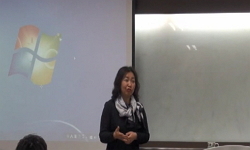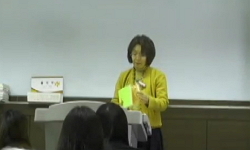The purpose of this research is to compare the two translations of Chinese children's literature, to organize the translation aspects that each appeared inductively, and to study what strategies are needed for quality Chinese-Korean children's literat...
http://chineseinput.net/에서 pinyin(병음)방식으로 중국어를 변환할 수 있습니다.
변환된 중국어를 복사하여 사용하시면 됩니다.
- 中文 을 입력하시려면 zhongwen을 입력하시고 space를누르시면됩니다.
- 北京 을 입력하시려면 beijing을 입력하시고 space를 누르시면 됩니다.
https://www.riss.kr/link?id=T16621301
- 저자
-
발행사항
서울 : 韓國外國語大學校 大學院, 2023
-
학위논문사항
학위논문(석사) -- 韓國外國語大學校 大學院 , KFLT(외국어로서의한국어번역전공) , 2023. 2
-
발행연도
2023
-
작성언어
한국어
- 주제어
-
DDC
495.1802 판사항(22)
-
발행국(도시)
서울
-
기타서명
A research on translation strategies in Chinese-Korean children's literature translation : Focusing on comparison between the first and revised editions of Maplewood Ford
-
형태사항
iii, 90 p. : 삽도 ; 26 cm
-
일반주기명
한국외국어대학교 논문은 저작권에 의해 보호받습니다.
지도교수: 채호석
참고문헌: p. 86-88 -
UCI식별코드
I804:11059-200000660818
- 소장기관
-
0
상세조회 -
0
다운로드
부가정보
다국어 초록 (Multilingual Abstract)
By looking at the overall characteristics of the two translations, the first edition was more faithful to the source text, and the revised edition preferred readability. Considering the specificity of children's literature, it is reasonable to intervene, such as omitting and adding explanations or transformations by the translators. However, the problem is that the excessive emphasis on readability resulted in a translation with poor fidelity. This problem became evident in the revised edition, with excessive omissions and over-specifications. In the revised edition, the omissions of the original text affected the original author's intention to convey. It also resulted in a decrease in the aesthetic quality of the original work.
There is no need to adhere to absolute principles regarding translation methods, as various positions and arguments are possible concerning fidelity and readability. The standard for determining 'good translation' is inevitably different depending on the situation. There can be various judgments depending on the purpose of translation and the subject who consumes the translation. Consequently, accurately understanding the content and form of the source language and aiming for a translation that is easy for readers to understand is the matching point of a 'good translation'. Furthermore, translated text should be accurately translated without errors and distortions of the author's intention. Under the preference of readability, translators should be careful not to omit or add content not in the original text arbitrarily. It is because omissions or additions in translation lower the quality of children's literature.
The purpose of this research is to compare the two translations of Chinese children's literature, to organize the translation aspects that each appeared inductively, and to study what strategies are needed for quality Chinese-Korean children's literature translation by considering them with error analysis.
By looking at the overall characteristics of the two translations, the first edition was more faithful to the source text, and the revised edition preferred readability. Considering the specificity of children's literature, it is reasonable to intervene, such as omitting and adding explanations or transformations by the translators. However, the problem is that the excessive emphasis on readability resulted in a translation with poor fidelity. This problem became evident in the revised edition, with excessive omissions and over-specifications. In the revised edition, the omissions of the original text affected the original author's intention to convey. It also resulted in a decrease in the aesthetic quality of the original work.
There is no need to adhere to absolute principles regarding translation methods, as various positions and arguments are possible concerning fidelity and readability. The standard for determining 'good translation' is inevitably different depending on the situation. There can be various judgments depending on the purpose of translation and the subject who consumes the translation. Consequently, accurately understanding the content and form of the source language and aiming for a translation that is easy for readers to understand is the matching point of a 'good translation'. Furthermore, translated text should be accurately translated without errors and distortions of the author's intention. Under the preference of readability, translators should be careful not to omit or add content not in the original text arbitrarily. It is because omissions or additions in translation lower the quality of children's literature.
목차 (Table of Contents)
- 1. 서론 1
- 1.1 연구목적 및 필요성 1
- 1.2 선행연구 4
- 1.3 연구대상 및 연구방법 11
- 1. 서론 1
- 1.1 연구목적 및 필요성 1
- 1.2 선행연구 4
- 1.3 연구대상 및 연구방법 11
- 2. 이론적배경 17
- 2.1 아동문학 번역의 특성 17
- 2.2 가독성과 충실성 21
- 2.3 아동문학에서의 가독성과 충실성 23
- 3. 초판과 개정판의 비교 33
- 3.1 내용적요소 33
- 3.1.1 생략 34
- 3.1.2 명시화 40
- 3.1.3 의미부연 47
- 3.2 표현적요소 49
- 3.2.1 어휘와 표현의 적절성 50
- 3.2.2 문장길이 53
- 3.2.3 높임법 57
- 3.3 구성적요소 60
- 3.3.1 겉표지의 변화 60
- 3.3.2 장수의 변화 61
- 3.4 오류분석 62
- 3.4.1 잉여적 명시화로 인해 충실성이 저하된 번역 63
- 3.4.2 생략으로 인해 충실성이 저하된 번역 65
- 3.4.3 오역으로 인해 충실성이 저하된 번역 72
- 4. 초판과 개정판의 전략 비교 75
- 4.1 초판의 번역전략 76
- 4.2 개정판의 번역전략 76
- 4.3 초판과 개정판의 번역전략 비교 78
- 5. 결론 82
- 참고문헌 86
- ABSTRACT 89











